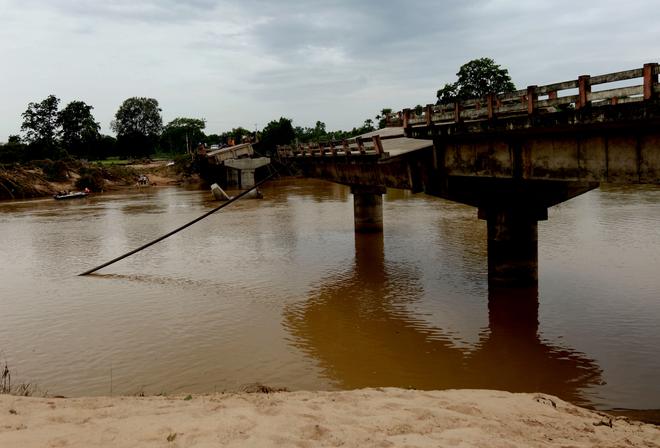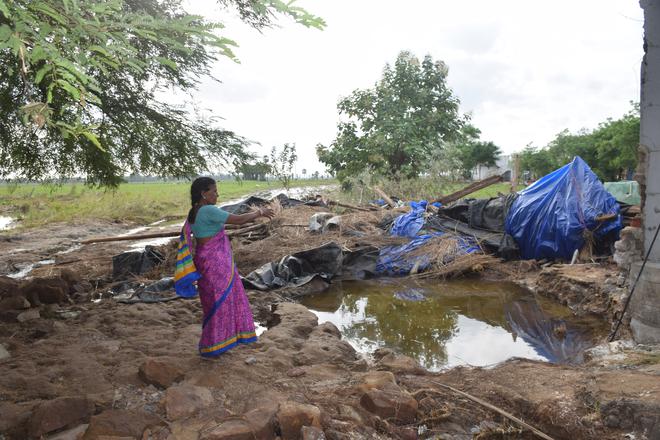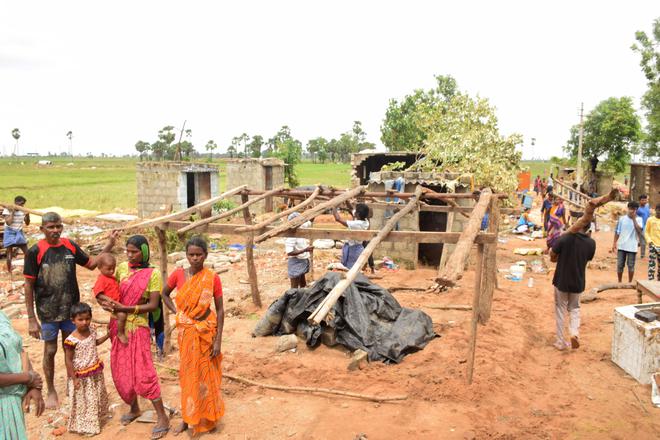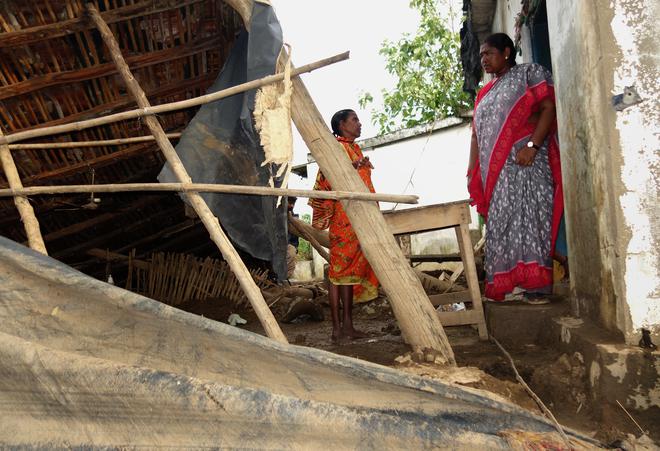What started as a drizzle on the morning of July 26 turned into torrential rain by the night. Mohammed Raheem living in Projectnagar village of Mulugu district in north-eastern Telangana, decided to shift his flock of sheep to an adjacent hilly area.
Even as the rain came down in sheets, the shepherd stepped out of the bamboo-roof hut. He took his oldest child, a six-year-old son, Sadiq Pasha, to the elevated place, asking his wife Fauzia to remain in the hut and take care of the other two children, a 4- and 3-year-old, Tanvir and Saddam.
While some, even the elderly, walked up to the forest nearby, others went up the double-storey school building. “The mother with her two tiny tots remained in the hut. She was unaware that the hut was in a low-lying area,” Mulugu Sub-Divisional Police Officer N. Ravinder recalled.
The flood water entered the hut and continued to rise by the next morning. Scared for their safety, Fauzia climbed atop the hut’s bamboo-sheet roof. “She was holding Tanvir with one arm and Saddam with the other. Around 5.45 a.m., the speeding, swirling waters swept away the hut, the mother, and the two children,” the officer explained.
That evening, little Saddam’s body was found a kilometre away. Fauzia’s body was traced the next day, and that of toddler Saddam surfaced in the water four days later, leaving villagers shell shocked. Little did they or villagers of Kondai, located a few kilometres downstream, realise that an even bigger tragedy was going to unfold.
Having recorded the highest rainfall of 64.98 cm — from 8 a.m. on July 26 to 8 a.m. on July 27 — in the history of the State, the district was devastated with road breaches, destroyed houses, and traumatised families. State Revenue Secretary, in a report presented in Telangana High Court in PIL petition, stated out of total 41 rain-related deaths in the State, 15 were from Mulugu, the district with lowest population in the State.
The main reason for the flood was the Godavari tributary, the Jampanna Vagu that begins from the Laknavaram lake in Mulugu district. With lush green crops on both sides, the 35 km long river is about 15-20 metres wide at its narrowest point and 60 metres wide at the Medaram bridge. Originally called the Lakhnavaram river, the current name stuck because the local tribes believe Jampanna, a warrior and son of tribal goddess Sammakka died fighting the Kakatiya army in Medaram, another village in the Mulugu district.
A river in spate
Rain bucketed down in major parts of Mulugu district on July 27 and 28. Strangely, there was not a single drop in Kondai village. Most of the nearly 100 families there are marginal farmers living in tiled-roof or thatched-roof mud houses. Some raise cattle to meet home needs of milk. Almost every house rears farm chicks. Dodla and Kondai villages are on either side of Jampanna Vagu.
Hamlet Malyala, at a higher level, is connected to Kondai by a recently laid gravel road with a culvert of cement concrete pipes down the middle. Coming after a long dry spell, the rains in the last week of July lit up everyone’s faces in Telangana. Equally happy were Kondai villagers on learning of heavy rains in their Mulugu district.


Soon, the mood changed. An uneasy anxiety crept into them as the Jampanna Vagu flood water began entering their fields. “Over 100 villagers went up to a double-storeyed building for safety. Some decided to walk up to adjacent Malyala,” said sarpanch K. Venkateshwarlu. By 1.30 p.m on July 27, the river flood water was overflowing on to the road connecting to Malyala. Though the water was waist deep, they dared to cross since they had been using the road for the past several years.
While Venkateshwarlu was overseeing shifting operations in the village, his wife Rama Devi along with her sexagenarian mother D. Sammakka walked towards the road along with some villagers. Holding hands, they entered the waist deep water. “Somehow, they stepped onto the deep soil abutting the culvert, lost balance while a wave pulled them into the gushing water,” her family said.
While struggling in the water, Devi caught hold of her mother’s hair and tried to save her. But the strong current pushed her mother away. Devi too was washed away, but got entwined in the agriculture motor wires about 100 metres away. “We were shouting, crying as people trying to wade through the water were being swept away in front of our eyes in broad daylight,” said B. Sarayya and B. Narayana of Malyala said.
Rasheed Khan and his wife Kareema Bee too were crossing the culvert with others when sudden surging water turned them upside down. “Rasheed was in his mid-50s but was well built. Being a swimmer, he came up from the spinning water, but his scared wife embraced him tightly,” one of the eyewitnesses explained. As they watched helplessly, the couple drowned even as Rasheed tried to swim ashore hugging his wife.
“It was heart wrenching to see the bodies of Rasheed and Kareema Bee in an embracing position 500 yards away after a few hours,” the sarpanch said.
Five more adults got washed away in a similar fashion within the next few minutes, notwithstanding attempts of the villagers to save them by throwing them ropes and long sticks. Teams of Mulugu police and members of the National Disaster Response Force tried to reach the village on learning of the tragedy. They had to stop at Dodla village with nearly half of the bridge (connecting Malyala and Kondai) over Jampanna Vagu getting washed away.
Mulugu witnessed a couple of more such distressing tragic deaths. Three of a family got washed away at Burugupet village of Venkatpur mandal following a breach of a tank. A watchman of a mango tree on the bank of Jampanna Vagu near Madaram bridge went up a tree to save his life from the deluge on July 26 night. “The next morning, there was no trace of him. Massive mounds of sand replaced the entire mango garden,” said a farmer, B. Keshavalu.
Devotees of Sammakka Sarakka, the tribal deities at Medaram, which witnesses a jathara (congregation) once in two years where lakhs of devotees gather, were worried as the Jampanna Vagu flood entered the temple. “Never in history has this happened,” said a roadside shop owner, Rathnakumari, adding that the tributary is usually dry. Life is limping back to normalcy as authorities are beginning to relay roads.
Kondia is still cut off from the rest of the world with the bridge connecting it with Dodla washed away in the floods. A person has to cross the river in a government-operated boat from Dodla and walk down a slushy road for 3 km to reach Kondai. “We can rebuild our houses. How can we bring back our loved ones lost in flood?” the devastated villagers say.
In the neighbouring district
Almost every one of the 980 villagers of Moranchapally, located along the National Highway 353C, 9 km from the coal town of Bhupalpally, has a traumatic near-death experience to narrate after the Morancha stream flash floods. It submerged the 2 km village stretch, leaving three dead and one missing. The ordeal unfolded at 3.45 a.m. on July 27 after the stream rose menacingly high, swamping the village. A crucial road link between Telangana and Maharashtra was also flooded and portions damaged due to the turbulent swirl of the stream.


The Morancha stream runs a course of nearly 23 kilometres originating from Ramappa lake-bed in Venkatapur mandal of Mulugu district. The flooding was preceded by unprecedented rainfall of 616.5 mm in the neighbouring Chityal mandal, 459.8 mm in Regonda mandal, and 457.0 mm in Chelpur in a 24-hour period, ending at 8.30 a.m. on July 27.
The record-breaking rains caused a breach in the Maredugudem tank, and several other tanks and lakes consequently overflowed in the upstream area, pushing up the water level in the Morancha stream, resulting in the flood havoc.
As the floodwaters raged around their huts, panic-stricken villagers climbed atop the roofs of a few houses. Some clung onto trees to escape death.
Those who managed to carry their mobile phones made distress calls to the “100” and their near and dear ones.
“My wife Mahalakshmi heard the roar of floodwaters virtually knocking at our door at about 3.45 a.m. on the ill-fated day. We both came out to climb up onto the roof,” said Gaddam Srinivas, a sand quarry worker, who escaped death by a whisker. “When we opened the door, the floodwaters gushed in prompted us to grab hold of a small tree right in front of our house.”
That saved them for nearly half an hour before a dead buffalo came along with the flood flow hitting his wife, he recalled. “She vanished in the deluge before I could do anything,” Srinivas said, his voice choking. It has been almost a week, but his wife is still untraceable despite a vigorous search operations by the police in the downstream of Moranchavagu.
“We endured heavy rain, stranded on the terrace of our house with our children and parents for almost seven hours till the rescue teams reached our village in inflatable boats,” said Devender, another survivor.
The deluge swept away everything which came its way: household articles, electronic appliances, cars, bikes, gold ornaments, and important papers.
Devender lives with the guilt of the survivor: “Our neighbours [Gorre Odireddy, 70, and his wife Vajramma, 60] were washed away while trying to reach high ground,” he said detailing heart-rending scenes that emerged during the flood havoc.
“My 75-year-old mother Sarojana, who was bed-ridden, was washed away after the deluge barrelled through the hutment she was sleeping in,” said Kausalya, her daughter, crying.
Members of about 20 families of the Chenchu tribe from the village are the worst hit. “We woke up to a nightmare after the surging floodwaters encircled our hutments in the predawn hours and all of us fled the spot, scaled a compound wall of a building in our neighbourhood, and somehow reached a rooftop,” said Ramaswamy, a middle-aged man of a Chenchu family. But he is thinking ahead, pleading with the government to allot two-bedroom houses to them.
“I had witnessed flash floods in Moranchavagu in 1983 and 2000 but our houses were spared from the deluge both times,” said Ravinder Reddy, a local farmer. This time, he said, the speed of the deluge was unusual as the stream rapidly swelled within an hour, changing its course, submerging the village.
In the ensuing rescue operations around noon on July 27, all the stranded villagers were ferried to flood relief camps at Karakpalli and Gandhinagar in Ghanpur mandal in inflatable boats. Two Indian Air Force helicopters were also pressed into service to aid the rescue and relief operations.
The government announced a ₹4 lakh ex-gratia to the kin of those killed in the flash floods in Moranchapally and disbursed a financial assistance of ₹10,000 each to about 320 families affected by the deluge. Official sources said a compensation of ₹30,000 for the loss of cattle will be paid soon.
Widespread damage was caused to crops in over 33,500 acres; 486 houses were partially and 42 houses fully damaged; 1,164 poultry and cattle died; 110 km of roads were damaged in the Jayashankar Bhupalpally district.

Nurseries of chilly and paddy spread over nearly 7,000 acres got damaged in Mulugu. While 45 houses got destroyed, 258 houses were partially damaged in the floods. Minister Satyavathi Rathod camped at Mulugu for two consecutive days overseeing relief measures. Mulugu MLA D. Anasuya alias Seethakka visited every affected village.
Though the floodwaters receded the next day with a lull in the torrential rains, the ravaged village has been hit by gloom. The survivors are struggling to remove the heaps of sludge piled in their damaged houses, salvaging whatever they can.
“We are staring at an uncertain future. Our cattle, the prime source of our livelihood, is lost,” said Lalitha, one of the survivors, as she slowly starts the cleaning process.







